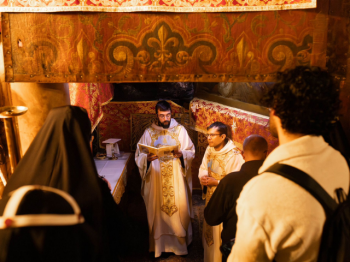Celebrating the Birth of Jesus in Bethlehem during wartime

On December 11, 2024, in the quiet anticipation of Advent experienced in closeness to the victims of the ongoing conflict in the Holy Land, two Christians in Bethlehem—a father and son— are preparing humble decorations in the cloister of the Church of Saint Catherine, in the city of the Nativity. That day, only a handful of passersby came to gather there in prayer. Silence reigned in the place where Christ was born.
This year, the authorities requested that Christmas be celebrated calmly. As Brother Daoud Kassabry, Director of the Christian Brothers’ College in Jerusalem, explains, “We limited ourselves to religious acts— praying, meditating, and pleading with the Lord to send His peace.” This discretion reflected a desire to share in the suffering of all. “We could not experience joy while others were weeping.”
Humanly speaking, given the horrifying circumstances so many people are facing, it was difficult to rejoice and fully embrace the joy of Christmas in such a context as this. Cardinal Pierbattista Pizzaballa, Latin Patriarch of Jerusalem, who had just returned from an intense pastoral visit to Gaza, acknowledged in his December 24 homily his personal struggle: “I find it hard to announce to you here, and to those around the world looking to Bethlehem, the joy of Christ’s Christmas.” For Christians, therefore, it was not possible to stifle their pain and replace it with a false and hypocritical light. No one in the Holy Land could be deceived in such a way.
As the Patriarch reminded us, it was precisely in the darkness of the night—the night of the Savior’s birth—that the shepherds “listened to the angels and believed.” The celebration of Christmas arrived quietly, much like the moment when Mary and Joseph welcomed the child in their circumstances of the most extreme poverty, yet guided by an extraordinary supernatural strength, in faith, and hope. While faith is a gift that resides in the hearts of these Christians, hope is a fruit that must be cultivated. The Cardinal emphasized the importance of “choosing” and “deciding” with “courage” to follow Christ and live in this land. The Christian scouts of the Holy Land demonstrated this by marching without drums toward the Basilica of the Nativity as part of the Patriarch’s entrance procession, bearing witness to the vibrant presence of young people who represent a promise for the Mother Church, cherished by baptized believers worldwide. Cardinal Pizzaballa’s fraternal message then invited all to look toward the future with confidence: “Our commitment […] is that from this Christmas onward, coming here, we will reveal our faith and hope in favor of life in Bethlehem and northern Palestine.”
The Basilica of the Nativity did not see a large influx of pilgrims for Midnight Mass, which allowed many local Christians from Bethlehem and nearby areas—who had previously been unable to attend due to space constraints—to fill its pews. However, some foreign worshipers made their way to Christ’s cradle, including five French pilgrims, who are witnesses to unwavering faith in a troubled world. In this atmosphere of quiet joy, the Nativity Grotto became a true tabernacle of prayer throughout the night, with Masses celebrated in various languages as Christians gathered in simplicity to celebrate Christmas.
The message conveyed by this Christmas in the Holy Land, with its gentle strength, is what Georges Bernanos described as the “heroic determination of the soul, whose highest form is despair overcome.” It is an invincible hope that becomes reality in our lives through the birth of Christ.
Damaris Vayne
(January 2025)



